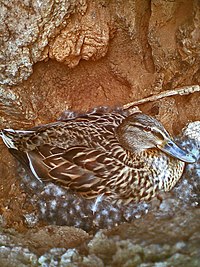
Photo from wikipedia
ABSTRACT Heatwaves are a regular occurrence in Australia, and are predicted to increase in intensity and duration in the future. These changes may elevate temperatures inside lizard nests, shortening the… Click to show full abstract
ABSTRACT Heatwaves are a regular occurrence in Australia, and are predicted to increase in intensity and duration in the future. These changes may elevate temperatures inside lizard nests, shortening the incubation period, so that hatchlings are more likely to emerge during heatwaves. Potentially, developmental plasticity or heat hardening could buffer hatchings from future warming. For example, higher incubation temperatures could shift critical thermal maxima upwards, enabling lizards to withstand higher temperatures. To investigate whether developmental plasticity affects hatchling thermal tolerance, we incubated eggs of the velvet gecko Amalosia lesueurii under two fluctuating incubation treatments to mimic current (mean=24.3°C, range 18.4–31.1°C) and future ‘hot’ (mean=28.9°C, range 19.1–38.1°C) nest temperatures. We maintained the hatchlings under identical conditions, and measured their thermal tolerance (CTmax) aged 14 days and 42 days. We then released hatchlings at field sites, and recaptured individually marked lizards aged 6 months, to determine whether incubation induced shifts in thermal tolerance were transitory or long-lasting. We found that at age 14 days, hatchlings from hot-temperature incubation had higher CTmax [mean=39.96±0.25°C (s.d.)] than hatchlings from current-temperature incubation [mean=39.70±0.36°C (s.d.)]. Hatchlings from the current-incubation treatment also had significantly higher heat hardening capacity [mean=0.79±0.37°C (s.d.)] than hatchlings from hot-temperature incubation treatment [mean=0.47±0.17°C (s.d. )]. However, both of these incubation-induced effects did not persist into later life. By contrast, incubation treatment had significant and long-lasting effects on the cold tolerance of hatchlings. At age 14 days, current-incubated hatchlings tolerated colder temperatures [CTmin=11.24±0.41°C (s.d.)] better than hot-incubated hatchlings [CTmin=14.11±0.25°C (s.d.)]. This significant difference in cold tolerance persisted into the juvenile life stage, and was present in 6-month-old lizards that we recaptured from field sites. This finding indicates that upward shifts in cold tolerance caused by higher incubation temperatures might affect overwinter survival of lizards, but field studies linking fitness to thermal tolerance are necessary to test this idea. Overall, our results suggest that developmental plasticity for heat tolerance is unlikely to buffer lizard populations from higher temperatures. This article has an associated First Person interview with the first author of the paper. Summary: Hatchling geckos from current temperature incubation tolerated cold better than hatchlings from future temperature incubation. The developmental shift in cold tolerance persisted for 6 months, and could therefore influence hatchling survival.
Journal Title: Biology Open
Year Published: 2019
Link to full text (if available)
Share on Social Media: Sign Up to like & get
recommendations!